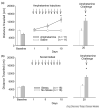Stress and Rodent Models of Drug Addiction: Role of VTA-Accumbens-PFC-Amygdala Circuit
- PMID: 20016773
- PMCID: PMC2794209
- DOI: 10.1016/j.ddmod.2009.03.010
Stress and Rodent Models of Drug Addiction: Role of VTA-Accumbens-PFC-Amygdala Circuit
Abstract
Stress can trigger, intensify, and prolong drug consumption, as well as reinstate previously extinguished drug-taking behavior by directly impacting a neural circuit often referred to as a reward pathways. Animal models of drug abuse have been used to understand these neural circuits mediating stress-induced drug intake and relapse through examination of cellular and subcellular molecular mechanisms. Several types of intermittent stressors have been shown to induce cross-sensitization to psychomotor stimulants, enhance conditioned place preference under most conditions, increase self-administration of cocaine and amphetamine and induce reinstatement of heroin and cocaine seeking via activation of the mesocorticolimbic dopamine system.
Conflict of interest statement
Jasmine J. Yap and Klaus A. Miczek have no conflicts to declare.
Figures


Similar articles
-
VTA glutamatergic projections to the nucleus accumbens suppress psychostimulant-seeking behavior.Neuropsychopharmacology. 2024 Nov;49(12):1905-1915. doi: 10.1038/s41386-024-01905-3. Epub 2024 Jun 26. Neuropsychopharmacology. 2024. PMID: 38926603 Free PMC article.
-
Limbic and motor circuitry underlying footshock-induced reinstatement of cocaine-seeking behavior.J Neurosci. 2004 Feb 18;24(7):1551-60. doi: 10.1523/JNEUROSCI.4177-03.2004. J Neurosci. 2004. PMID: 14973230 Free PMC article.
-
Selective inactivation of the dorsomedial prefrontal cortex and the basolateral amygdala attenuates conditioned-cued reinstatement of extinguished cocaine-seeking behavior in rats.Psychopharmacology (Berl). 2003 Jul;168(1-2):57-65. doi: 10.1007/s00213-002-1196-x. Epub 2002 Sep 5. Psychopharmacology (Berl). 2003. PMID: 12845418
-
Drug addiction, relapse, and the amygdala.Ann N Y Acad Sci. 2003 Apr;985:294-307. doi: 10.1111/j.1749-6632.2003.tb07089.x. Ann N Y Acad Sci. 2003. PMID: 12724166 Review.
-
Stress-Induced Reinstatement of Drug Seeking: 20 Years of Progress.Neuropsychopharmacology. 2016 Jan;41(1):335-56. doi: 10.1038/npp.2015.142. Epub 2015 May 15. Neuropsychopharmacology. 2016. PMID: 25976297 Free PMC article. Review.
Cited by
-
Sex differences in vulnerability to addiction.Neuropharmacology. 2021 Apr 1;187:108491. doi: 10.1016/j.neuropharm.2021.108491. Epub 2021 Feb 7. Neuropharmacology. 2021. PMID: 33567305 Free PMC article. Review.
-
Cross-sensitization between cocaine and acute restraint stress is associated with sensitized dopamine but not glutamate release in the nucleus accumbens.Eur J Neurosci. 2013 Mar;37(6):982-95. doi: 10.1111/ejn.12121. Epub 2013 Jan 29. Eur J Neurosci. 2013. PMID: 23360446 Free PMC article.
-
Spermidine, a positive modulator of the NMDA receptor, facilitates extinction and prevents the reinstatement of morphine-induced conditioned place preference in mice.Psychopharmacology (Berl). 2020 Mar;237(3):681-693. doi: 10.1007/s00213-019-05403-z. Epub 2019 Dec 11. Psychopharmacology (Berl). 2020. PMID: 31828395
-
Cross-talk between the HPA axis and addiction-related regions in stressful situations.Heliyon. 2023 Apr 17;9(4):e15525. doi: 10.1016/j.heliyon.2023.e15525. eCollection 2023 Apr. Heliyon. 2023. PMID: 37151697 Free PMC article. Review.
-
Neurobiological intersections of stress and substance use disorders.Front Neurosci. 2025 May 1;19:1548372. doi: 10.3389/fnins.2025.1548372. eCollection 2025. Front Neurosci. 2025. PMID: 40376607 Free PMC article. Review.
References
-
- Kosten TR, Gawin FH, Rounsaville BJ, Kleber HD. Cocaine abuse among opioid addicts: demographic and diagnostic factors in treatment. Am J Drug Alcohol Abuse. 1986;12:1–16. - PubMed
-
- Dembo R, Williams L, Schmeidler J, Berry E, Wothke W, Getreu A, Wish ED, Christensen C. Physical abuse, sexual victimization, and illicit drug use: replication of a structural analysis among a new sample of high-risk youths. Violence Vict. 1989;4:121–138. - PubMed
-
- Brown SA, Vik PW, Patterson TL, Grant I, Schuckit MA. Stress, vulnerability and adult alcohol relapse. Journal of Studies on Alcohol. 1995;56:538–545. - PubMed
-
- Harrison PA, Fulkerson JA, Beebe TJ. Multiple substance use among adolescent physical and sexual abuse victims. Child Abuse & Neglect. 1997;21:529–539. - PubMed
-
- Jacobsen LK, Southwick SM, Kosten TR. Substance use disorders in patients with posttraumatic stress disorder: A review of the literature. American Journal of Psychiatry. 2001;158:1184–1190. - PubMed
Grants and funding
LinkOut - more resources
Full Text Sources
Miscellaneous
